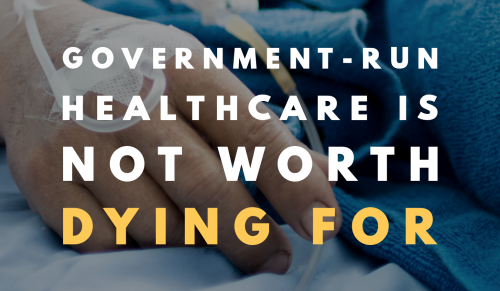 Waiting for Care
Waiting for Care
government-run healthcare

Government-run health care has many names:
single-payer, Medicare for All, and "Berniecare" to name a few. No matter what you call it, replacing the United States' health care system with government bureaucracy is not the right policy for Americans.
The United Kingdom and Canada made the jump to a universal health care system long ago—with disastrous results. Without a competitive marketplace for medicine, the government—not doctors and patients—decides what treatments are available and how much money can be spent on health care.
With similar government-run healthcare, it is predicted that Americans will have a one-size-fits-all health care system that diminishes individual choice of service, doctor, location and timing for treatment with few options outside the system.
Dispelling the Myths
Supporters of Medicare for All argue that quality and access to health care is better in countries with socialized medicine.
A look at the real outcomes of universal health care in Canada and the UK shows that Americans have nothing to gain from Medicare for All—and everything to lose.
The Reality of “Free” Health Care in Canada and the United Kingdom
It's basic economics: When a valuable commodity like health care suddenly becomes "free," demand will increase while supply stays the same. This always results in shortages. In the case of health care, those shortages lead to rationing of medical care in order to control the new demand.
In Canada and the UK, "free" care does not equal access on-demand or guarantee high-quality.
Long Wait Times
- Among developed nations, Canada’s health care system ranks last for elective surgeries, emergency room treatments, specialist examinations, and same-day or next-day treatments.
- In 2017, Canadian patients routinely waited over five months between scheduling an initial appointment to actually receiving treatment. This is the longest wait time on record.
- In December 2017 in the UK, the number of people awaiting treatment was about four million. The number of patients who had been waiting over a year was 1,750.
- In January 2018 in the UK, 80,000 patients waited on hospital gurneys for more than four hours. Of those patients, 1,000 waited for over 12 hours.
- For planned care, the UK’s National Health System (NHS) referral-to-treatment standard is 4.5 months. The emergency room four-hour wait time limit hasn’t been met since July 2015. The 62-day wait-time limit for cancer patients hasn’t been met in over three years.
- It’s been estimated that at least an extra 10,000 patients have died while waiting for care in the UK in 2018.
Cancelled Procedures
- In 2017, 88,685 operations in the UK were cancelled for non-clinical reasons on the day they were scheduled to be performed. Nearly 4,000 of those procedures were urgent.
- In March of 2018, 1 in 7 operations were cancelled on the scheduled day for surgery in the UK.
Extreme Hospital Overcrowding
When a greater percentage of health care is paid for by insurance, the more health care services are accessed. The UK’s National Health Service (NHS) admitted that uncontrolled use of health care is a growing issue. Canada has also struggled to develop ways of incentivizing people to use less “free” healthcare.
- In the winter of 2017, Canadian hospitals suffered from extreme overcrowding. Hospitals were frequently operating at 100 percent capacity or more.
- Patients in Canada and the UK have routinely been left waiting in hallways—in some instances, in bathrooms—due to a lack of available beds.
Decreased Access to Care for At-Risk Patients
Long wait times have an acute impact on elderly patients, who are forced to wait on the side lines as younger healthier patients take advantage of free doctor visits for minor symptoms.
- Procedures for elderly patients—including knee or hip replacements and cataract surgery—are considered “non-urgent” and therefore have longer wait times.
- A study done in the UK found that on average, elderly patients waited 182 days for long-term care spots to open up.
- Long-term care facilities can skip over patients who require more care—such as those with dementia—to cut costs.
The Consequences of Government-Run Health Care in the United States
Senator Bernie Sanders’ proposed Medicare for All bill “specifies that healthcare providers including hospitals, physicians, and others will be reimbursed for all patients at Medicare payment rates.”
As a result of this, Charles Blahous of the Mercatus Center estimates that payments made to hospitals and doctors will be reduced by 40 percent.
Hospital Closures and Doctor Shortages
Some hospitals will be forced to shut down, and many doctors could choose to close their private practice—a trend that will be compounded by the impending physician shortage.
Both the UK and Canada face medical staff shortages.
- 62 percent of Intensive Care Units (ICU) in the UK cannot function normally due to lack of nurses.
- In parts of Canada,it can be extremely difficult to find a family physician due to a growing lack of private practices.
Decreased Access to Emergency Care
With patients facing longer wait times to see their general practitioner, more head to the emergency room for minor ailments.
- In 2017, the city of Ottawa had 322 instances where there were no ambulances available to respond to emergencies.
- In cases where ambulances were available, paramedics spent 37,423 hours in emergency room parking lots waiting to offload their patients.
- In just one week in the UK in 2017, 16,900 people waited in the back of an ambulance—4,700 of them waited for more than an hour
- In the UK, from 2017-2018, 1 in 6 patients spent longer than 4 hours in the emergency department.
- In the winter of 2017 in the UK, 62 senior Accident & Emergency (A&E) doctors wrote a letter to the Prime Minister documenting that thousands of patients were left waiting in ambulances and that more than 120 patients a day were being managed in hallways—some dying prematurely given all the restrictions imposed on availability of care.
Unsustainable Cost and Increased National Debt
Senator Sanders’ Medicare for All bill will cost an estimated $32 trillion over the first 10 years. The costs would increase in three main ways.
- Expand insurance to the currently uninsured—an estimated 89 percent increase in cost
- Require services provided to include dental, vision, and hearing
- Require “no cost-sharing, including deductibles, coinsurance, copayments, or similar charges, be imposed on an individual”
Medicare administrative costs seem low because according to CMS, Medicare only verifies the legitimacy of less than 0.3 percent of its 1.5 billion claims. This minimal administrative oversight resulted in $36.2 billion in improper payments in 2017 for only 15 percent of the population.
Once 100 percent of the population is on Medicare, either administrative costs will skyrocket in an attempt to mitigate fraud or the government will payout trillions more of improper payments due to poor administrative oversight—adding to the already predicted unsustainable costs.
(Charles Blahous’ Mercatus study, cited here, reaches similar conclusions on the total cost of Medicare for All as the Urban Institute’s 2016 study and the Center for Health and Economy’s 2016 study.)
Surviving Socialized Medicine
For a national health care system to work efficiently, it requires the participation—willing or unwilling—of every patient and provider. If not, the whole system collapses.
Senator Sanders' Medicare for All bill would prevent doctors and patients from opting-out of socialized care. This means when looking for treatment, patients will be limited to the options decided for them by the Secretary of Health and Human Services or travelling to another country for uninsured care.
This is the model followed in Canada, where quality and access to care deteriorated enough that in 2016, it was estimated 63,459 Canadians elected to receive medical treatment outside of Canada—typically in the U.S.—and to pay the uninsured cost that came with it.
